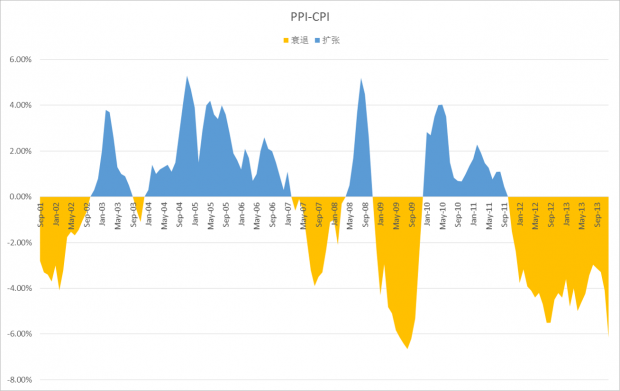截至4月份,PPI与CPI之差已经连续19个月为负。这说明了什么呢?
在《美国大萧条》一书中对这种价格变化差异的本质做出了解释:
“奥地利学派的理论进一步揭示了通胀并不是政府货币供应增加和信用扩张的唯一不幸后果。因为这种扩张扭曲了投资和生产的结构,造成在资本货物行业不良项目上的过度投资。这种扭曲反映在一个众所周知的事实中,即在每个繁荣时期,资本商品的价格上涨超过消费品。于是,商业周期的衰退阶段就变得不可避免,因为衰退是必要的矫正过程,在这期间市场清除在繁荣扩张时期的不良投资,把资源从资本货物行业重新导向到消费品行业。货币和信用膨胀式扭曲持续的越长,衰退调整就必须更剧烈。在衰退期间,资源转移以资本商品相对于消费品价格下降的方式进行。”
“The Austrian theory further shows that inflation is not the only unfortunate consequence of governmental expansion of the supply of money and credit. For this expansion distorts the structure of investment and production, causing excessive investment in unsound projects in the capital goods industries. This distortion is reflected in the well-known fact that, in every boom period, capital goods prices rise further than the prices of consumer goods. The recession periods of the business cycle then become inevitable, for the recession is the necessary corrective process by which the market liquidates the unsound investments of the boom and redirects resources from the capital goods to the consumer goods industries. The longer the inflationary distortions continue, the more severe the recession-adjustment must become. During the recession, the shift of resources takes place by means of capital goods prices falling relative to consumer goods. ”
简而言之,PPI相对于CPI下降是市场自发的资源重新配置。这种重新配置通过价格的相对变化而实现。人为阻止这种市场的自发调节会延长市场扭曲,从而造成更严重的衰退。

从过去十三年的历史记录可以看出,从2002年开始到2007年初PPI一直相对于CPI是上涨的,显示了货币与信用的扩张时期,经济结构被扭曲。而2007年到2008年PPI开始相对于CPI下降,市场开始自我调节,但马上被信用扩张所短暂打断。2009年这个自我调节过程再次开始,但又被2010年到2011年的大规模信用扩张所打断。进入2012年,市场的自我调节顽强的重新开始,这次的调节力度更强,持续时间也更长。按照目前的预测,这个过程至少要持续到年底。但是,这个市场的自我调节过程会不会再次被打断呢?如果被再次打断,那么下面呢?还有下面吗?
0
推荐




 京公网安备 11010502034662号
京公网安备 11010502034662号 